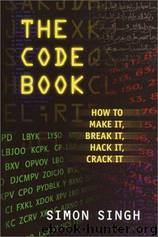The Code Book by Simon Singh

Author:Simon Singh [Singh, Simon]
Language: zho
Format: epub, mobi, pdf
Tags: #genre
ISBN: 9780385730624
Publisher: Delacorte Books for Young Readers
Published: 2003-08-12T14:01:11+00:00
5 The Language Barrier
While British codebreakers were breaking the German Enigma cipher and altering the course of the war in Europe, American codebreakers were having an equally important influence on events in the Pacific arena by cracking the Japanese machine cipher known as Purple. For example, in June 1942 the Americans deciphered a message outlining a Japanese plan to draw U.S. Naval forces to the Aleutian Islands by faking an attack, which would allow the Japanese Navy to take their real objective, Midway Island. Although American ships played along with the plan by leaving Midway, they never strayed far away. When American cryptanalysts intercepted and deciphered the Japanese order to attack Midway, the ships were able to return swiftly and defend the island in one of the most important battles of the entire Pacific war. According to Admiral Chester Nimitz, the American victory at Midway “was essentially a victory of intelligence. In attempting surprise, the Japanese were themselves surprised.”
Almost a year later, American cryptanalysts identified a message that showed the itinerary for a visit to the northern Solomon Islands by Admiral Isoruko Yamamoto, Commander-in-Chief of the Japanese Fleet. Nimitz decided to send fighter aircraft to intercept Yamamoto’s plane and shoot him down. Yamamoto, renowned for being compulsively punctual, approached his destination at exactly 8:00 A.M., just as stated in the intercepted schedule. There to meet him were eighteen American P-38 fighters. They succeeded in killing one of the most influential figures of the Japanese High Command.
Although Purple and Enigma, the Japanese and German ciphers, were eventually broken, they did offer some security when they were initially implemented and provided real challenges for American and British cryptanalysts. In fact, had the cipher machines been used properly—without repeated message keys, without cillies, without restrictions on plugboard settings and scrambler arrangements, and without stereotypical messages which resulted in cribs—it is quite possible that they might never have been broken at all.
The true strength and potential of machine ciphers was demonstrated by the Typex (or Type X) cipher machine used by the British army and air force, and the SIGABA (or M-143-C) cipher machine used by the American military. Both these machines were more complex than the Enigma machine and both were used properly, and therefore they remained unbroken throughout the war. Allied cryptographers were confident that complicated electromechanical machine ciphers could guarantee secure communication. However, complicated machine ciphers are not the only way of sending secure messages. Indeed, one of the most secure forms of encryption used in the Second World War was also one of the simplest.
During the Pacific campaign, American commanders began to realize that cipher machines, such as SIGABA, had a fundamental drawback. Although electromechanical encryption offered relatively high levels of security, it was painfully slow. Messages had to be typed into the machine letter by letter, the output had to be noted down letter by letter, and then the completed ciphertext had to be transmitted by the radio operator. The radio operator who received the enciphered message then had
Download
The Code Book by Simon Singh.epub
The Code Book by Simon Singh.mobi
The Code Book by Simon Singh.pdf
This site does not store any files on its server. We only index and link to content provided by other sites. Please contact the content providers to delete copyright contents if any and email us, we'll remove relevant links or contents immediately.
| Cryptography | Encryption |
| Hacking | Network Security |
| Privacy & Online Safety | Security Certifications |
| Viruses |
Effective Threat Investigation for SOC Analysts by Yahia Mostafa;(6541)
Practical Memory Forensics by Svetlana Ostrovskaya & Oleg Skulkin(6258)
Machine Learning Security Principles by John Paul Mueller(6231)
Attacking and Exploiting Modern Web Applications by Simone Onofri & Donato Onofri(5902)
Operationalizing Threat Intelligence by Kyle Wilhoit & Joseph Opacki(5863)
Solidity Programming Essentials by Ritesh Modi(4013)
Microsoft 365 Security, Compliance, and Identity Administration by Peter Rising(3656)
Operationalizing Threat Intelligence by Joseph Opacki Kyle Wilhoit(3388)
Future Crimes by Marc Goodman(3346)
Mastering Python for Networking and Security by José Manuel Ortega(3344)
Mastering Azure Security by Mustafa Toroman and Tom Janetscheck(3330)
Blockchain Basics by Daniel Drescher(3294)
Learn Computer Forensics - Second Edition by William Oettinger(3152)
Mobile App Reverse Engineering by Abhinav Mishra(2880)
Incident Response with Threat Intelligence by Roberto Martínez(2871)
Mastering Bitcoin: Programming the Open Blockchain by Andreas M. Antonopoulos(2868)
The Code Book by Simon Singh(2823)
From CIA to APT: An Introduction to Cyber Security by Edward G. Amoroso & Matthew E. Amoroso(2779)
Building a Next-Gen SOC with IBM QRadar: Accelerate your security operations and detect cyber threats effectively by Ashish M Kothekar(2713)
